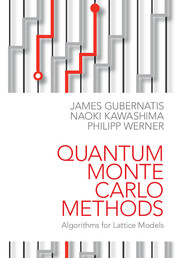Book contents
- Frontmatter
- Contents
- Preface
- Part I Monte Carlo basics
- Part II Finite temperature
- Part III Zero temperature
- 9 Variational Monte Carlo
- 10 Power methods
- 11 Fermion ground state methods
- Part IV Other topics
- Appendix A Alias method
- Appendix B Rejection method
- Appendix C Extended-ensemble methods
- Appendix D Loop/cluster algorithms: SU(N) model
- Appendix E Long-range interactions
- Appendix F Thouless's theorem
- Appendix G Hubbard-Stratonovich transformations
- Appendix H Multi-electron propagator
- Appendix I Zero temperature determinant method
- Appendix J Anderson impurity model: chain representation
- Appendix K Anderson impurity model: action formulation
- Appendix L Continuous-time auxiliary-field algorithm
- Appendix M Continuous-time determinant algorithm
- Appendix N Correlated sampling
- Appendix O The Bryan algorithm
- References
- Index
11 - Fermion ground state methods
from Part III - Zero temperature
Published online by Cambridge University Press: 05 May 2016
- Frontmatter
- Contents
- Preface
- Part I Monte Carlo basics
- Part II Finite temperature
- Part III Zero temperature
- 9 Variational Monte Carlo
- 10 Power methods
- 11 Fermion ground state methods
- Part IV Other topics
- Appendix A Alias method
- Appendix B Rejection method
- Appendix C Extended-ensemble methods
- Appendix D Loop/cluster algorithms: SU(N) model
- Appendix E Long-range interactions
- Appendix F Thouless's theorem
- Appendix G Hubbard-Stratonovich transformations
- Appendix H Multi-electron propagator
- Appendix I Zero temperature determinant method
- Appendix J Anderson impurity model: chain representation
- Appendix K Anderson impurity model: action formulation
- Appendix L Continuous-time auxiliary-field algorithm
- Appendix M Continuous-time determinant algorithm
- Appendix N Correlated sampling
- Appendix O The Bryan algorithm
- References
- Index
Summary
In this chapter, we discuss the fixed-node and constrained-path Monte Carlo methods for computing the ground state properties of systems of interacting electrons. These methods are arguably the two most powerful ones presently available for doing such calculations, but they are approximate. By sacrificing exactness, they avoid the exponential scaling of the Monte Carlo errors with system size that typically accompanies the simulation of systems of interacting electrons. This exponential scaling is called the Fermion sign problem. After a few general comments about the sign problem, we outline both methods, noting points of similarity and difference, plus points of strength and weakness. We also discuss the constrained-phase method, an extension of the constrained-path method, which controls the phase problem that develops when the ground state wave function cannot be real.
Sign problem
The “sign problem” refers to the exponential increase of the Monte Carlo errors with increasing system size or decreasing temperature (e.g., Loh et al., 1990, 2005; Gubernatis and Zhang, 1994) that often accompanies a Markov chain simulation whose limiting distribution is not everywhere positive. Such a case generally arises in simulations of Fermion and frustrated quantum-spin systems. It seems so inherent to Monte Carlo simulations of Fermion systems that the phrase “the sign problem” to many seems almost synonymous with the phrase “the Fermion sign problem.”
Explanations for the cause of the sign problem vary and are still debated. In this chapter, we choose to summarize two explanations that seem to connect the causes in ground state Fermion simulations in the continuum and on the lattice. The sign problem, of course, is not limited to ground state calculations or even to Fermion simulations. While the cause we discuss in Sections 11.2 and 11.3 focuses on the low-lying states of diffusion-like operators, several topological pictures have been proposed (Muramatsu et al., 1992; Samson, 1993; Gubernatis and Zhang, 1994; Samson, 1995). Some of these discussions are done in the context of the zero- and finite-temperature determinant methods (Muramatsu et al., 1992; Gubernatis and Zhang, 1994). Others are done more analytically from a Feynman path-integral point of view (Samson, 1993, 1995). Some are for particles with statistics other than Fermions. The presentation of the sign problem in this chapter is appropriate for the Monte Carlo methods discussed in this chapter.
Information
- Type
- Chapter
- Information
- Quantum Monte Carlo MethodsAlgorithms for Lattice Models, pp. 338 - 364Publisher: Cambridge University PressPrint publication year: 2016
